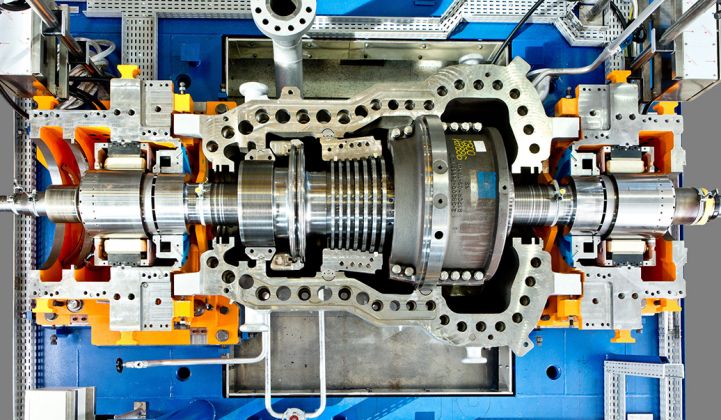In the midst of a global pandemic, Siemens is pressing ahead with plans to spin off its energy units, including its majority stake in wind turbine maker Siemens Gamesa Renewable Energy, into a new business.
If the goal is to maximize the proceeds, the timing for Siemens Energy's IPO may prove to be terrible. But for a struggling manufacturer looking to ride out the storm, even a reduced windfall would be a welcome one.
Siemens first announced plans to spin off its power and gas businesses and merge them with Siemens Gamesa Renewable Energy (SGRE) a year ago, and later asked its employees to choose a name for the new energy-focused entity. They came up with the unshowy and straightforward "Siemens Energy." But that’s where the simple or straightforward part of the process ends.
The IPO, scheduled for September, would be a blockbuster by European standards. A Siemens spokesperson confirmed to GTM that the plan is to continue with that timeline.
Management questions
Technically, Siemens Energy doesn’t even exist yet, but it’s already had two CEOs. The first CEO-designate, Siemens veteran Michael Sen, left after six months in his new role after reportedly clashing with the parent company over Siemens Energy's future.
Bloomberg reported on plans to charge the new firm several hundred million euros to use the brand name and for back-office services. Reuters said Sen and CFO-designate Michael Patzak wanted the parent company to retain a much smaller stake in Siemens Energy than the 50 percent figure that has been discussed.
While Europe was getting its head around the impact of the coronavirus in late March, Sen and Patzak left Siemens and a new management team was lined up for Siemens Energy.
Siemens already faced a tough IPO market
The IPO landscape was already cloudy, and that was before the pandemic storm rolled in.
Many high-profile IPOs stumbled last year, including WeWork and Lyft. The number of floats and the funds raised both fell about 20 percent compared to the previous year, according to global accounting firm PwC. In Germany, it was the poorest year for new issuances since the financial crash in 2008.
Siemens’ CEO, Joe Kaeser, plans to leave later this year when his contract runs out. Simplifying the German conglomerate’s business has been a hallmark of his tenure, and the energy spinoff will be the final phase of his contribution to that process.
Speaking on the firm’s quarterly investor call in February, Kaeser said: “Siemens Energy, in particular, can and will play a significant role in supporting the global energy transition from conventional generation to renewable energy and supplying technology to produce synthetic fuels for the high growth in [the] economy.”
The “cornerstone” of the new business will be SGRE, Kaeser added.
That Siemens Energy will immediately become a major player in the global power business is beyond doubt. The new firm will, according to Siemens, have annual revenue on the order of €30 billion ($32.6 billion) and an order backlog of €70 billion.
Like its rival General Electric, Siemens' gas turbine division has struggled in recent years — cannibalized to some degree by the success of its renewable energy business. Still, many investors will be interested in a company that is the world's dominant supplier of offshore wind turbines and the fourth-largest supplier of onshore machines, according to Wood Mackenzie data.
The question Siemens must wrestle with is whether postponing an IPO process that Kaeser has described as already having involved a “hell of a lot of work” would be better than sticking to the schedule and potentially accepting a lower valuation. Germany’s DAX share index is down about 25 percent on where it was pre-COVID-19.
Will Siemens Gamesa benefit?
Siemens Gamesa, which trailed only Denmark's Vestas last year in overall wind turbine deliveries globally, would be a central plank of Siemens Energy's strategic future.
The spinoff would see Siemens transferring its 67 percent ownership in separately listed SGRE to the new Siemens Energy. Siemens merged its wind turbine business with Spanish rival Gamesa in 2017. (Spanish utility Iberdrola sold its remaining 8.1 percent stake in SGRE to Siemens in February.)
Before the coronavirus led SGRE to pull its 2020 guidance, the turbine maker expected annual revenue of €10.2 billion to €10.6 billion, equivalent to a third of Siemens Energy's anticipated annual intake. By comparison, SGRE contributes a single-digit percentage of revenue to the Siemens group in its current form.
It seems reasonable that some of the IPO proceeds would filter through to the turbine business, which is growing faster than the global wind turbine market itself. But if Siemens does hold onto a large chunk of Siemens Energy, keeping potential shares off the market, and throws in some hefty licensing fees to boot, the question will be how much is left to reinvest in the wind business.
2020 is shaping up to be a rocky year for the world's wind turbine makers. The coronavirus pandemic has temporarily closed many factories and exacerbated a shortage of raw materials for blades. Both Vestas and SGRE have suspended their financial forecasts for the year, and Wood Mackenzie trimmed 4.9 gigawatts from its global wind forecast for 2020 in late March.
If SGRE’s new home as part of Siemens Energy proves to be a nurturing one, it could be well-positioned to absorb higher component and raw materials pricing, expedite logistics to get projects back on track and ensure its manufacturing facilities are optimized to hit delivery dates.
Investors and the global renewables market will be watching closely for information and clues when SGRE and Siemens report their first-quarter earnings later this week.
Given the current uncertainty, a straightforward result for the IPO in September may be seen by many as a win.




